#ziphiidae
Explore tagged Tumblr posts
Text
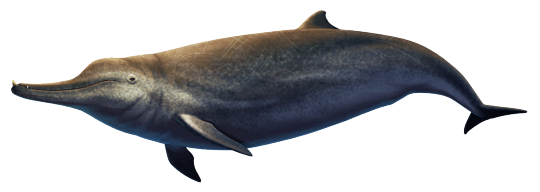
Ninoziphius platyrostris was an early beaked whale that lived during the late Miocene (~6 million years ago) in warm coastal waters covering what is now southwestern Peru. Its ancestors appear to have branched off from all other beaked whales very early in the group's history, indicating a "ghost lineage" going back to at least 17 million years ago.
About 4.4m long (~14'5"), it was less specialized for suction feeding and deep diving than modern beaked whales. Also unlike most modern species its jaws were lined with numerous interlocking teeth, with heavy wear suggesting it may have hunted close to the seafloor, where disturbed sand and grit would have regularly ended up in its mouth along with its prey and steadily ground down its teeth during its lifetime.
Males had a pair of stout tusks at the tip of their upward-curving lower jaw, with possibly a second smaller set of tusks behind them, which were probably used for fighting each other like in modern beaked whales.
Its shallow water habitat and more abrasive diet suggest Ninoziphius' lifestyle was much more like modern dolphins than modern beaked whales, and other early beaked whales like Messapicetus similarly seem to have occupied dolphin-like ecological niches.
These dolphin-like forms disappeared around the same time that true dolphins began to diversify, possibly struggling to compete for the same food sources, while other beaked whales that had begun to specialize for deep sea diving survived and thrived. Interestingly this ecological shift seems to have happened twice, in two separate beaked whale lineages – although only one of them still survives today – with bizarre bony "internal antlers" even independently evolving in both groups.
———
NixIllustration.com | Tumblr | Patreon
References:
Bianucci, Giovanni, et al. "New beaked whales from the late Miocene of Peru and evidence for convergent evolution in stem and crown Ziphiidae (Cetacea, Odontoceti)." PeerJ 4 (2016): e2479. https://doi.org/10.7717/peerj.2479
Bianucci, Giovanni, et al. A new Late Miocene beaked whale (Cetacea, Odontoceti) from the Pisco Formation, and a revised age for the fossil Ziphiidae of Peru. Bollettino della Societa Paleontologica Italiana 63.1 (2024): 21-43. https://www.researchgate.net/publication/380459192_A_new_Late_Miocene_beaked_whale_Cetacea_Odontoceti_from_the_Pisco_Formation_and_a_revised_age_for_the_fossil_Ziphiidae_of_Peru
Gol'din, Pavel. "‘Antlers inside’: are the skull structures of beaked whales (Cetacea: Ziphiidae) used for echoic imaging and visual display?." Biological Journal of the Linnean Society 113.2 (2014): 510-515. https://doi.org/10.1111/bij.12337
Lambert, Olivier, Christian De Muizon, and Giovanni Bianucci. "The most basal beaked whale Ninoziphius platyrostris Muizon, 1983: clues on the evolutionary history of the family Ziphiidae (Cetacea: Odontoceti)." Zoological Journal of the Linnean Society 167.4 (2013): 569-598. https://doi.org/10.1111/zoj.12018
Lambert, Olivier, et al. "No deep diving: evidence of predation on epipelagic fish for a stem beaked whale from the Late Miocene of Peru." Proceedings of the Royal Society B: Biological Sciences 282.1815 (2015): 20151530. https://doi.org/10.1098/rspb.2015.1530
#science illustration#paleontology#paleoart#palaeoblr#ninoziphius#ziphiidae#beaked whale#odontoceti#toothed whale#cetacean#whale#artiodactyla#ungulate#mammal#art
262 notes
·
View notes
Text
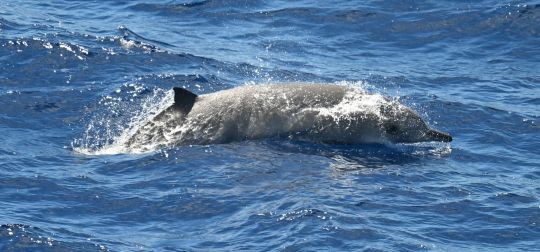
Gray's beaked whale Mesoplodon grayi
Observed by afahawkins, CC BY-NC
32 notes
·
View notes
Text
#2487 - Mesoplodon layardii - Strap-toothed Beaked Whale
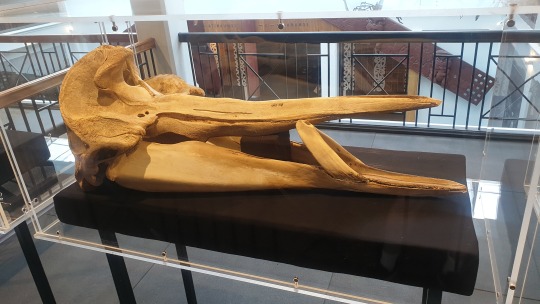
Named after the bizarre teeth, and Edgar Leopold Layard, the curator of the South African Museum, who sent drawings of a skull to the British taxonomist John Edward Gray, who described the species in 1865.
Largest of the Mesoplodons, growing to 6.2m in length, despite the fact that the strap-like tusks stop them opening their jaws more than 3cm. At least the females aren't so encumbered. It seems certain the teeth are used in male-male combat, but the only actual damage comes from a small spike on the tip of the teeth.
Sporadic strandings and sightings suggest the whale is widespread in the Southern Ocean, although one individual did show up in Myanmar in 2011.
Mostly a squid-feeder, caught by suction feeding. Hunted by orca, and harmed by sonar.
Whanganui Regional Museum, New Zealand
#mesoplodon#ziphiidae#beaked whale#strap-toothed beaked whale#tw: dead animal#cetacean#strap-toothed whale
48 notes
·
View notes
Text
Round 3 - Mammalia - Artiodactyla
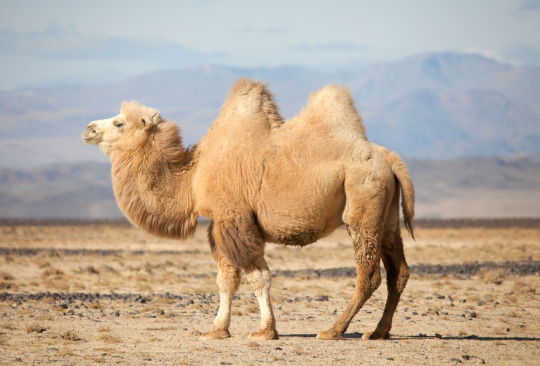


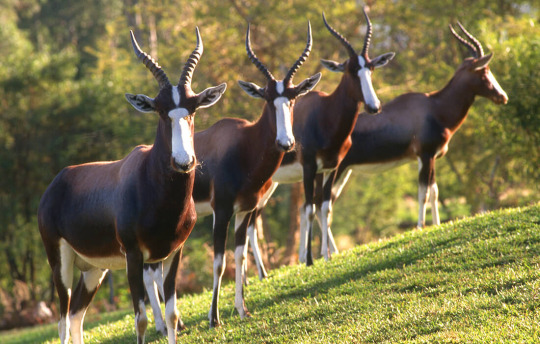
(Sources - 1, 2, 3, 4)
Our final order of mammals, and second order of ungulates is Artiodactyla, commonly referred to as “even-toed ungulates”. Artiodactyla is a large and highly diverse group which includes the living families Camelidae (“camels”, “vicuñas”, “guanacos”, and kin), Suidae (“pigs”), Tayassuidae (“peccaries”), Hippopotamidae (“hippopotamuses”), Balaenidae (“right whales” and “Bowhead Whale”), Cetotheriidae (“Pygmy Right Whale”), Balaenopteridae (“rorquals”), Eschrichtiidae (“Gray Whale”), Delphinidae (“oceanic dolphins”), Monodontidae (“Beluga Whale” and “Narwhal”), Phocoenidae (“porpoises”), Kogiidae (“Pygmy and Dwarf Sperm Whales”), Physeteridae (“Sperm Whale”), Iniidae (“South American river dolphins”), Platanistidae (“south Asian river dolphins”), Pontoporiidae (“La Plata Dolphin”), Ziphiidae (“beaked whales”), Tragulidae (“chevrotains”), Antilocapridae (“Pronghorn”), Giraffidae (“giraffes” and “Okapi”), Cervidae (“deer”), Moschidae (“musk deer”), and Bovidae (“cattle”, “antelopes”, “goats”, and kin).
Artiodactyls are typically defined by the fact that they bear most of their weight equally on two or four of the five original ungulate toes. However, all living members of the infraorder Cetacea have lost their toes, replacing them with flipper-like limbs. Many artiodactyls have a relatively large head, with an elongated and narrow skull. Some families have cranial appendages, which include true horns, antlers, ossicones, or pronghorns. True horns have a bone core that is covered in a permanent sheath of keratin, and are found only in the Bovids. Antlers are bony structures that are shed and replaced each year, only found in deer. Artiodactyls have a well-developed sense of smell and sense of hearing. Similar to many other prey animals, their eyes are on the sides of the head, giving them an almost panoramic view, so that they can keep an eye out for predators while grazing. This order is highly diverse, ranging in size from the rabbit-sized Java Mouse-deer (Tragulus javanicus) to the largest mammal, and possibly the largest animal to ever exist: the Blue Whale (Balaenoptera musculus). Most are herbivorous, but many are omnivores or even carnivores.
Male artiodactyls are usually larger than females. In the majority of deer species, only the males grow antlers, and the horns of female bovines are usually smaller or absent. As this is a very diverse group, social and mating behavior vary between species. They have a tendency to form larger groups, but some live alone or in pairs. Species living in groups often have a hierarchy, both among males and females. Some species also live in harem groups, with one male, several females, and their common offspring. In other species, the females and juveniles stay together, while males are solitary or live in bachelor groups and seek out females only during mating season. Generally, artiodactyls tend to have long gestation periods, smaller litter sizes, and more highly-developed young (usually called a “calf”). Most deliver 1 or 2 calves at a time, but some pigs can deliver up to ten. Newborn artiodactyls are precocial and are born with hair and open eyes.
The oldest fossils of artiodactyls date back to the early Eocene (about 53 million years ago).

Propaganda under the cut:
More than half the species in the family Camelidae are domesticated, with the only living wild camelids being the Vicuña (Lama vicugna) (ancestor of the domestic Alpaca), the Guanaco (Lama guanicoe) (ancestor of the domestic Llama), and the Wild Bactrian Camel (Camelus ferus) (NOT the ancestor of the Domestic Bactrian).
Camelids have true canine teeth and tusk-like premolars, which are separated from the molars by a gap.
Both the Bactrian Camel (Camelus bactrianus) (image 1) and the Dromedary (Camelus dromedarius) were domesticated in ancient times for riding, transport, ploughing, and as a source of milk, meat, wool, and leather. Today, the wild ancestors of both of these species are extinct, and only feral populations of domestic camels remain. The only truly wild camel species left is the Wild Bactrian Camel (Camelus ferus), which is critically endangered.
The Wild Bactrian Camel can survive on water saltier than seawater, something which no other mammal in the world seems to be able to tolerate, including the domestic Bactrian Camel.
In Aymara mythology, Llamas (Lama glama) are sacred beings. The Heavenly Llama is said to drink water from the ocean and urinates as it rains. According to Aymara eschatology, llamas will return to the water springs and ponds where they come from at the end of time.
Babirusas (genus Babyrousa) are unique for their prominent, upwards incurving, canine tusks, which pierce out through the flesh of the snout in males. The upper canine tusks continue growing, curving backward over the front of the face and towards the forehead. If a male Babirusa does not grind his tusks (achievable through regular activity), they can eventually keep growing and, rarely, even penetrate the individual's skull.
The Domestic Pig (Sus domesticus) was domesticated from the Wild Boar (Sus scrofa) beginning in the Neolithic, and is a result of two different domestication events in both the Middle East and China. They are mostly kept for meat and leather, but are also used in medicine and as pets. The Domestic Pig is one of the few omnivorous animals to be domesticated.
The endangered Chacoan Peccary (Catagonus wagneri) is the rarest of the 3 living species of peccary, with only around 3,000 individuals left in the world. It is a “Lazarus taxon”, as its genus was first described from fossil remains of the extinct Catagonus metropolitanus. The Chacoan Peccary only lives in hot, dry, thorny areas of the Gran Chaco.
While the semi-aquatic hippopotamuses were once more diverse, only two species of different branching lineages remain: the vulnerable Common Hippopotamus (Hippopotamus amphibius) (see gif above) and the endangered Pygmy Hippopotamus (Choeropsis liberiensis).
The Egyptian goddess Tawaret is depicted as a pregnant woman with a hippopotamus head, representing fierce maternal love.
Humans have hunted whales since prehistoric times, with depictions of whaling dating back to 6000 BC. Whales are hunted for their meat, blubber, and oil. Whale oil was in high demand for lighting lamps in the 18th century. The Sperm Whale (Physeter macrocephalus) was particularly prized for spermaceti, a dense waxy substance that burns with an exceedingly bright flame that is found in the whale’s spermaceti organ. Approximately 40% of Right Whales' (genus Eubalaena) (image 3) body mass is blubber, and thus they were known as the "right" whale to kill. Today, the North Atlantic Right Whale (Eubalaena glacialis) is the most critically endangered great whale, with around 372 individuals left in the world. While whale hunting has been significantly curtailed in recent years, whales still face threats from entanglement in fishing gear, boat strikes, underwater noise pollution, plastic and heavy metals build-up, and accelerating climate change. Cetaceans are still hunted in some countries.
The Humpback Whale (Megaptera novaeangliae) is known to not only fight back against their main predators, Orcas (Orcinus orca), but also to interfere with Orca hunting parties, rescuing their prey.
The mysterious Narwhal (Monodon monoceros) is known for the long tusk of the males, which is a protruding left canine thought to function as a weapon, a tool for feeding, in attracting mates, or for sensing water salinity. Some males may grow two tusks, occurring when the right canine also protrudes through the lip. Some females may grow a tusk as well, but it is usually smaller than the tusks of males.
The critically endangered Vaquita (Phocoena sinus) is the smallest of all living cetaceans, reaching a maximum body length of 150 cm (4.9 ft) for females or 140 cm (4.6 ft) for males. The Vaquita is one of the most endangered animals in the world, with around 6-11 individuals remaining. They are endangered primarily due to bycatch in gillnets from the illegal Totoaba (Totoaba macdonaldi) fishery.
The Baiji (Lipotes vexillifer) was a river dolphin, and the last surviving member of the family Lipotidae. It is classified as "critically endangered: possibly extinct", as no specimens have been seen in the Yangtze River in over 20 years. Heavy use of the river for fishing, transportation, and hydroelectricity were the likely causes of this unique species’ extinction. While some individuals may survive, their population is likely too low to recover. If indeed extinct, the Baiji's disappearance would be the first recorded extinction of a well-studied cetacean species to be directly attributable to human influence.
The Pronghorn (Antilocapra americana) is the last surviving member of its family. While they are sometimes referred to as antelope, this is an example of convergent evolution, and their closest living relatives are the Giraffids. The Pronghorn is the fastest land mammal in the Americas, and the third fastest land mammal on Earth, with running speeds of up to 88.5 km/h (55 mph). This running speed was likely an adaptation to flee the Pleistocene American Cheetahs (genus Miracinonyx), which are now extinct.
Giraffes are the tallest living land animals, with the largest being the Masai Giraffe (Giraffa tippelskirchi). Bull Masai Giraffes can grow up to 5.5 meters (18 feet) in height, and weigh 1,300 kilograms (2,900 pounds).
Caribou (Rangifer tarandus), also known as Reindeer, are unique among Cervids in that females may have antlers, although the prevalence of antlered females varies by subspecies.
Cervid antlers are a controlled form of bone cancer. Antler growth is tightly regulated by the activity of tumor-suppressing and tumor-growth-inhibiting genes. The cancer-suppressing genes that keep growth in check also protect against cancer in general, and documented cancer rates in deer that are five times lower than rates in other mammals.
Musk Deer (genus Moschus) are not true deer belonging to the family Cervidae, but rather their family is most closely related to Bovidae. They are known for the enlarged upper canines, forming sabre-like tusks, grown by the males for display.
The family Bovidae is the largest of the artiodactyls, and ungulates in general, accounting for nearly 55% of the ungulates. They also contain the majority of domesticated animals.
The critically endangered Saola (Pseudoryx nghetinhensis) is also known as the “Asian Unicorn” due to its rarity. The first photograph of a living Saola was taken in captivity in 1993. The most recent one was taken in 2013 by a movement-triggered camera in the forest of central Vietnam.
The African Buffalo (Syncerus caffer), specifically the Syncerus caffer caffer subspecies, the Cape Buffalo, is known as one of the most dangerous animals in Africa. With nicknames like "the Black Death" or "the widowmaker", Cape Buffalos can be highly territorial and defensive, and wounded animals are reported to ambush and attack hunters. (However, Elephants, Nile Crocodiles, and Hippos are still responsible for more deaths per year than African Buffalos are. Not to mention mosquitoes and venomous snakes.)
Domestic Cattle (Bos taurus) and Zebu (Bos indicus) were both domesticated from the now extinct Aurochs (Bos primigenius) during the Neolithic revolution. While the Aurochs is now extinct, Domestic Cattle are the most successful members of their lineage, with over 1.4 billion cattle in the world.
The Springbok (Antidorcas marsupialis) is the fourth fastest land mammal, clocked at 88 km/h (55 mph). They are primarily known for their pronking behavior: bouts of repeated high leaps of up to 2m (6.7 ft) into the air. In pronking, the Springbok performs multiple leaps into the air in a stiff-legged posture, with the back bowed and the white fur on its rump raised. This behavior displays the fitness of males, both to attract mates and to ward off predators, who won’t waste time chasing a healthy, fit Springbok.
The Domestic Sheep (Ovis aries), domesticated from the Mouflon (Ovis gmelini) between 11,000 and 9000 BC in Mesopotamia, and the Domestic Goat (Capra hircus), domesticated from the Bezoar Ibex (Capra aegagrus aegagrus) around 8000 BC, were domesticated to provide easy access to meat, hides, dung (used for fuel), wool, and milk. It is thought that the birth of agriculture and domestication of livestock is what led to human civilizations, as it was hard to be nomadic with a large herd of animals. Villages popped up around pens of livestock, leading to towns, leading to cities.
#animal polls#round 3#mammalia#aaaah sorry this is late I had to sleep before I could finish it again ;_;
154 notes
·
View notes
Note
heyyy i was wondering of you have any wolverine fic recs or if you do those. if not its cool.
just fyi because wolverine is x-men we won't be posting wolverine fics but i can rec you deadpool x wolverine as that movie is marvel:
All I Want For Christmas is You (Deadpool Edition) (ao3) - jenniferlawrencelover logan/wade E, 52k
Summary: Wade never thought he would be engaged again.
And he wasn't.
Yet.
Sunshine and Whiskey (ao3) - that_one_dead_author logan/wade E, 40k
Summary: “Oho, there’s number two-oh-seven.” Wade laughs and Logan already knows he’s grinning beneath his cowl. “That fight really got ya goin’ huh?”
Logan hated the way he could feel his cheeks heat up. He snarled, “shut the fuck up, Red.” There was a spray of warm blood against Logan’s knuckles, a breathy groan from Wade sending a shiver down the older man’s spine.
Wade glanced out of a broken window to his right. “Isn’t he cute?” He asked an invisible audience. Logan rewarded him with another stab.
Wade’s attention turned back to Logan, gloved hands grabbing his hips and giving an experimental roll of his hips. Logan’s breath hitched, and Wade had the passing thought that he wanted to swallow the sound.
the bucket list (ao3) - mikaminato logan/wade E, 33k
Summary: Wade loses his mutation and his cancer returns. With only a little time left, he decides to create a bucket list and make the most of his final moments. Together with Logan, he tries to check off every item on the list.
That is, until Logan decides he's not ready to say goodbye just yet.
we got love sure enough (ao3) - ziphiidae logan/wade M, 30k
Summary: There’s something about the mundane that wrestles with Logan’s mind far more than violence ever has. He’s already proven to himself that he can be a hero. Now it’s time to prove he can once again be someone worthy of trust on a far more personal level. ___
Or, Logan and Wade's bumpy road to domesticity.
#Anonymous#answered#found#deadpool and wolverine#deadpool#wade wilson#logan wolverine#wolverpool#m/m
28 notes
·
View notes
Text
Don't forget the family ziphiidae!

WHALES!

WHALES!

WHALES!
It’s world whale day!!!!




WHALE WHALE WHALE WHALE WHALE

WOOOOOOO
1K notes
·
View notes
Photo
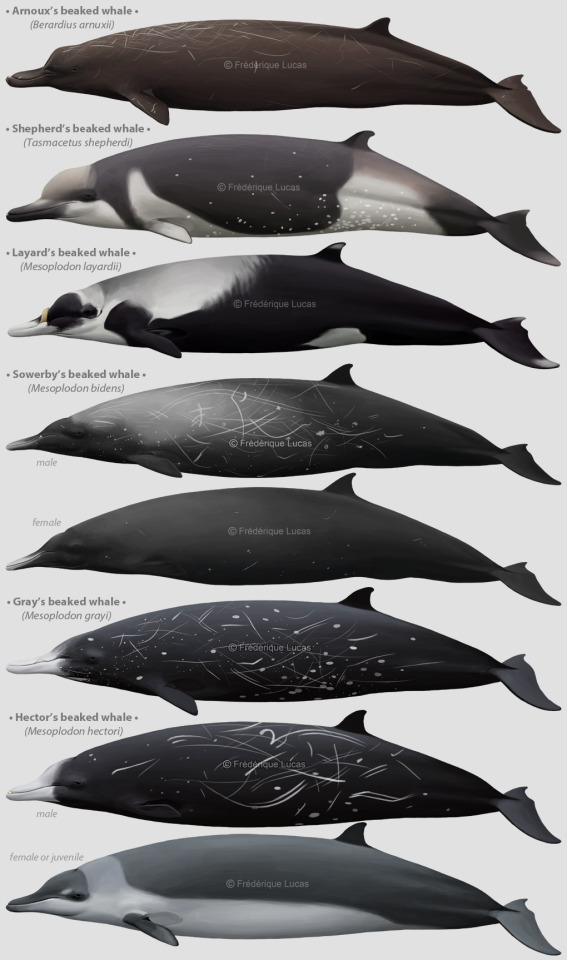

A bunch of beaked whales
I did mention I got to paint a lot of beaked whales, right? ;) After the bottlenose whales here are, well, the others. I thought it was nice to put them all together, really makes you appreciate the wonderful diversity within this big family (and it saves you from ‘a beaked whale a day’ for the next 1.5 weeks). There’s too many to all discuss individually but I have some favourites:
Shepherd’s beaked whale was a joy to paint as they are one of my favourites. Their markings are so beautiful, and they are also unique in being the only beaked whale to have a full set of teeth. For very long their colour pattern was unknown (and oft presumed to have this streaky pattern) until in 2006(!) their real colouration was formally described. They are a beautiful, elegant and unique looking species.
Sowerby’s beaked whale provided a similar ‘aha’ erlebnis for me. Often illustrated as a medium gray throughout (which is certainly fitting for the females) some interesting photographs of adult males showed a rather distinctive light blaze between their blowhole and dorsal fin. In some males it was very subtle, but others had almost as much contrast as a Layard’s beaked whale - I chose to illustrate something in the middle. Very interesting and something I hope will be the subject of further study. Males and females also have funny white lips.
Ramari’s beaked whale can’t be overlooked as it is the youngest member of the family: only described three months ago, in October 2021. Previously known as the southern form of the True’s beaked whale, analysis proved they were a species all of their own. Very happy to have painted this one too, as the mysterious southern True’s with their shining white peduncles always intrigued me.
And lastly, I can’t not mention Blainville’s beaked whale because take a closer look at that snout. Any whale whose mouth somehow ends up above their eyes is worthy of an extra look I think. And the Layard’s beaked whale because they have always been my number 1 favourite beaker.
#illustrations#scientific illustrations#beaked whales#Ziphiidae#beaked whale#Arnoux's beaked whale#Berardius arnuxii#Shepherd's beaked whale#Tasmacetus shepherdi#Layard's beaked whale#Strap-toothed whale#Mesoplodon layardii#Sowerby's beaked whale#Mesoplodon bidens#Gray's beaked whale#Mesoplodon grayi#Hector's beaked whale#Mesoplodon hectori#Ramari's beaked whale#Mesoplodon eueu#new species#True's beaked whale#Mesoplodon mirus#Blainville's beaked whale#Mesoplodon densirostris#digital art
209 notes
·
View notes
Photo



The Beautiful Cuvier’s Beak-nosed Whale
Requested by @swordhare
Don’t be fooled by its appearence; that’s no dolphin! It’s the Cuvier’s Beak-nosed Whale (Ziphius cavirostris), the most common of the beaked whale famile Ziphiidae. The Cuvier’s Beak-nosed Whale, also known as the goose-beaked whale, can be found in every ocean, although they are seldom seen. This is because they prefer deep waters, often diving below 1000m, and because beaked whales as a whole are shy creatures who retreat from human contact.
Z. cavirostris has become somewhat of a model for beaked whales, given that they are the most populus species and thus easier to study, despite their elusive nature. Goose-beaked whales generally travel in pods of about 15 individuals, although males sometimes travel alone. They are a deep-sea species and perhaps the deepest diving mammal on the planet; individuals have been recorded at depths of almost 3,000m and staying underwater for almost 4 hours at a time.
At such depths, Cuvier’s beak-nosed whales hunt squid, deep-sea fish, crabs and starfish. Like dolphins, they use echolocation to find their prey and communicate with each other, emitting a wide range of whistles, clicks, and groans. This is particularly useful in the deep sea where the absence of light limits the use of vision.
Little is known about the reproductive habits of beaked whales, including Z. cavirostris. They seem to mate and calf year-round, although where and how is a mystery. The average lifespan is 35 years, and predators may include sharks and orcas as evidenced by the white scars characteristic of older individuals.
In addition to being one of the more elusive whale species, the goose-beaked whale is also one of the smallest. They usually range from 5-7m long and weigh about 3000kg. One of the features that most easily distinguishes the Cuvier’s beaked-nose whale from dolphins and porpoises is their teeth. Unlike their look-alike cousins, this species only has two, which emerge in the form of tusks in males. Occasionally vestigial teeth will break through the gums, but they’re not considered useful in any meaningful way.
Conservation stuatus: This species is considered Least Concern by the IUCN. They can be caught in fishing nets as by-catch or by whalers, although these numbers are low enough to be disregarded. A larger threat is that of sonar, which has been known to drive large numbers of these whales to beach themselves and die of exposure or decompression sickness.
Photos
Todd Pusser
Andrew J. Read
M. Rosso
#cuvier's beak-nosed whale#Cetacea#ziphiidae#cetaceans#beaked whales#whales#mammals#marine fauna#marine mammals#pelagic fauna#pelagic mammals#open ocean#open ocean mammals#deep sea fauna#deep sea mammals#atlantic ocean#Pacific Ocean#indian ocean#biology#zoology#animal facts
197 notes
·
View notes
Link
#new whale just dropped#mesoplodon eueu#mesoplodon#ziphiidae#beaked whale#odontoceti#cetacean#artiodactyla#ungulate#mammal#marine mammals#new species
1K notes
·
View notes
Text
we got love sure enough by ziphiidae
where soul meets body by Edgebug
So Much For True Love by nbfutureboy
choked up, face down, burnt out (slow down, sit down, it’s new) by Chaos_and_Sparkles
some poolverine fics i've enjoyed recently <3 please make sure to read the tags!
tomorrow and tomorrow and tomorrow by signifier
Blood, Dirt, Love (Stop) by por_queeee
electrochemistry by Edgebug
Newton's Third Law by capitalismwasamistake
Body Count by cyclogenesis (addictedkitten)
hold me like a grudge by NotesAppWitch [series]
171 notes
·
View notes
Text

Northern bottlenose whale Hyperoodon ampullatus
With northern fulmar Fulmarus glacialis
Observed by rouj, CC BY-NC
The ghostly pale appearance of this bottlenose whale is an aberration from the more typical brownish coloration - probably a result of a tyrosinase deficiency, which affects the ability to synthesize melanin.
#Hyperoodon ampullatus#northern bottlenose whale#Cetacea#Ziphiidae#cetacean#whale#non-ungulate#bird#tubenose#Fulmarus glacialis#North America#Arctic Ocean#Davis Strait#aberrant coloration#keep reading
89 notes
·
View notes
Text
2 notes
·
View notes
Photo


Some more drawings of my wheagle beastie. Sketches of the head and skull from different angles, and studies of the tail/pygostyle anatomy. Someday I’d like to do a full dorsal reference of the animal (in addition to many other studies and illustrations!) but this tail ref will have to do for right now.
#creature design#bird creature#creature anatomy#creature skull#tail anatomy#bird anatomy#skull#concept art#musculature#tail muscles#beaked whale#ziphiidae#tail feathers#anatomy#muscle anatomy#labeled anatomy#anatomical drawing
18 notes
·
View notes
Text
Not a single representative of the family Ziphiidae? Shame!
It's the second largest cetacean family after dolphins.
Cuvier's beaked whale has dives recorded at depths of nearly 3,000 meters and holding their breath for over 3 hours.
Also, look at these guys:



Don't they remind you of ancient whales?
I look at these guys and I can easily see a connection to like dorudon or basilosaurids.
i have received the blessing (can make polls) so i ask again...

can't list em all, so poll options are based on responses when i asked this before here & on instagram, + some personal favs
975 notes
·
View notes
Text

Transactions of the Zoological Society of London, Vol XII, Part VIII, (1889)
#Wonder Rooms#Cabinet of Curiosities#Public Domain#Transactions of the Zoological Society of London#19th Century#Scientific Illustration#Marine Biology#Zoology#Animalia#Mammalia#Artiodactyla#Cetacea#Ziphiidae#Ziphius
6 notes
·
View notes
Photo

Phylogenomic Resolution of the Cetacean Tree of Life Using Target Sequence Capture
Cetaceans (whales, dolphins, and porpoises) have undergone the most dramatic morphological transformation of all mammals, having originated from a clade of terrestrial even-toed ungulates (like cattle, hippopotamuses, pigs, and more) over fifty million years ago. As a result of such an interesting and diverse evolutionary history, cetaceans have long been important and insightful subjects of numerous studies.
Until recently, the higher-level relationships between the cetacean families have taken precedence in research, leaving the systematics and lower-level relationships both under-explored and unresolved.
New research from Systematic Biology sought to rectify this gap in knowledge by combining data from >38,000 exons with existing sequences from 11 cetaceans and seven outgroup taxa, producing the first comprehensive comparative genomic dataset for cetaceans.
Enrich your knowledge further by exploring a more holistic insight of the genetic intricacies within cetacean families and discover new clarifications of the contentious relationships among particular species.
#Systematic Biology#Cetaceans#Phylogenomics#Delphinidae#Ziphiidae#Dolphins#Whales#Evolutionary Biology#Biology#Oxford University Press#Oxford Journals#High-throughput Sequencing#Phylogenetic Relationships#Target Sequence Capture#Macroevolution
81 notes
·
View notes